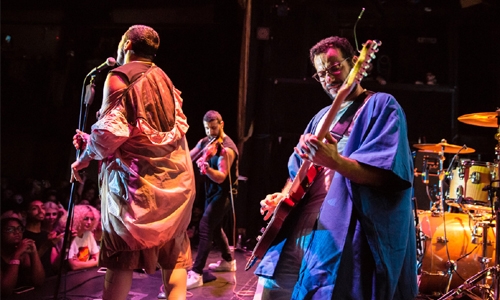Lebanese fashion designer reinvents Arab menswear
When London-based Lebanese fashion designer Nour Hage decided to shift from creating womenswear to menswear, she figured she’d check if any other Arab women were creating clothes for Arab men. “I don’t know of any others,” she says. “Nada Khoury in Beirut has a small menswear line, but that’s more about suits, it’s quite classical. And besides that I don’t know of any. I might be wrong, but I didn’t find anything.” So Hage’s recently launched Zero One collection, which takes clothes traditionally associated with the Middle East — abayas, thobes, et cetera — and gives them a distinct, contemporary feel, is something of an anomaly.
But it’s already proving popular among some of the most influential young cultural players in the Middle East, the wider Muslim world, and beyond. In September, for example, Emmy-winning British actor and rapper Riz Ahmed was on the cover of GQ in the UK. On the inside pages he was pictured wearing two items from Hage’s collection; an abaya and Satra (a jacket inspired by traditional Levantine wrapped coats). Other prominent artists to wear Hage’s designs include Iraqi-Canadian rapper Narcy and Kuwaiti multimedia artist Zahed Sultan, while Firas Abou Fakher — guitarist and keyboardist with the seminal Lebanese indie band Mashrou’ Leila — has performed in a striking blue abaya from Zero One.
These ‘brand ambassadors’ (not in the ‘paid-social-influencer’ sense, importantly) have been of great value to Hage. Not just because they’ve helped raise the profile of her work, but because they’ve proved that the people who she wanted to wear her clothes also want to wear them. “When I was designing the collection, I was thinking about who my target audience is,” she says. “The brand is about expressing pride in Arab culture and putting Arab identity at the forefront of the global market. It’s about bringing unique high-quality Arab design to the world.
I want people who aren’t Arabs to experience Arab design. “So I looked at who represents Arab culture in the best way possible — looking at, like, the ‘new type’ of Arab men. For me, Narcy is one of them, Zahed Sultan is one of them, Mashrou’ Leila… They’ve had such an impact on the new generation all over the Arab world, and on me personally and on my work,” she continues. “And Riz Ahmed, he’s an activist about representation in the media — having non-white people represented in big movies and TV shows, but not being stereotyped. So he was a perfect fit as well. “So I’d basically narrowed it down to a group of people and it turns out that not only did (that association) make sense in my head, it made sense in their heads.”
She laughs. “So it all worked out.” It’s an impressive roster of supporters for someone who’s only just started out in menswear. Hage launched her own womenswear brand in 2013, out of Beirut, having returned to her homeland when her French work permit (she was working for Paris-based German designer Damir Doma, who at the time, she says, was “kind of the darling of the fashion scene”) was rejected in early 2012. It wasn’t until she moved to London a couple of years ago that she decided to switch to menswear. “I wanted to rebrand completely,” she says. “I felt the need to bring out Arab culture and the traditional clothing that I think is beautiful, but was overlooked in the last few decades. There’s something really proud about the way Arab men dress, especially in the Gulf and North Africa.
I started researching and it sparked something inside me. I think it’s the best decision I’ve ever made for the brand.” It wasn’t an easy choice, though. “Menswear is much more challenging,” Hage says. “Men tend to buy for comfort more than aesthetics, whereas women tend to buy something because it looks nice rather than because it’s comfortable. But I like that challenge of designing something new and avant-garde and innovative, but in the frame of it being comfortable and practical.” Alongside the desire to meet that challenge, the primary influence on Zero One has been Hage’s research. “When you look at how men in the (MENA) region used to dress, their taste in clothes was very soft. They also wore a lot of colors. So it’s not like I’m doing something insanely new.
It all comes from research.”Take what Hage describes as the “key element” of her collection: the abaya. “Decades ago, farmers, merchants and landowners would all wear it. But depending on your social class you wore it in different types of fabrics and colors. So farmers and shepherds would wear it, but they’d also use it as a bag to carry food for animals, or as shelter when it rained. It was an overgarment that was also a practical thing. When you first look at it, you might think you wouldn’t wear it every day. But it’s actually really easy to wear. You just throw it on.” Her research also influenced smaller details too. Her shirts don’t have folded collars “because Arab men didn’t tend to wear ties.” They don’t have.
Related Posts

